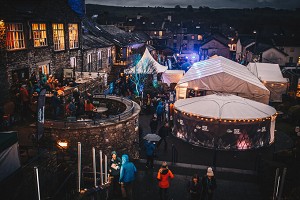
Jim Pope writes about his recent expedition to Kyrgyzstan, and his attempt to establish a new route on the Yellow Wall.
In August, a group of us headed to the Karavshin region in Kyrgyzstan to climb the famous big walls of the Ak-Su and Kara-Su valleys.
We spent the first two weeks in the Kara-Su and found our feet on lots of brilliant routes. The climbing in this valley felt a lot more adventurous, and often followed old aid lines with suggested sport grades which were often way off the mark. One of the most memorable days of the trip for me was attempting a new route, ground up, on the Yellow Wall.
At 450 metres, Yellow Wall is relatively small for this valley, but has a very proud shield of rock on the top third. It was on this face that Tommy Caldwell and Beth Rodden were shot at in their portaledge, whilst also trying to do a new route. Luckily for us, the conflicts in the region had settled down a lot, and we had a much tamer time on the wall!
Throughout our time in the Kara-Su, I gazed upon the headwall from various positions trying to spot a line. In our penultimate day I took the binoculars and found a potential line of weakness up the shield.
There were several crack systems, but they were split by large gaps. The red granite looked very compact, and blank/unprotected in sections. On our last day before heading to the Ak-Su, we went for a look!
The alarm at 5am was a harsh wake-up, and it was bitterly cold in the valley. I was pretty apprehensive about the climbing as it was likely to be bold, and we had no idea what we would find for anchors. Tom's alarm hadn't gone off, but I was not at all psyched, so I was happy to stay put for a while.
I had a slow breakfast and a few instant coffees then woke him at 7. I felt bad because he felt awful for sleeping in, but I was really glad for the later start. We walked in with the first light, far nicer than the dark approach we had planned, and arrived at the base of the wall.
We climbed the easy diagonal ramp for five pitches until we were below the shield. The line looked promising, and I began up the first pitch from the ledge. The initial rock was pretty bad, and I trended left through a steep roof and then turned the roof into the start of the crack system. The backdrop as I turned the roof was incredible, and we joked that this would become the best route in central Asia.
Finding some pegs in the thin crack was reassuring, as it gave some gear, as well as confidence that someone else had been here before. The pegs soon ran out, though, and I found myself perched in the middle of a blank slab.
Up high and right there was another peg, but it looked like difficult aid climbing to reach it. To my left was a big arching flake leading to a shoddy-looking anchor. I couldn't make out a way across to the flake so plucked up some courage to jump sideways to it. It felt really exposed, and I was worried about cutting my single rope on the pendulum if I fell off. I tied into my tagline and clipped that through the last bit of gear as a backup. After lots of psyching myself up, I went for it.
It was a huge jump and I didn't quite latch it. I took the pendulum on the old peg, the fall seemed to be okay so I had another few chucks but kept coming up short. Sat on the rope I saw some bigger footholds lower down. I managed a tricky traverse leftwards on thumb catches and made it to the flake. Upon reaching the feature I realised it was way too rounded, and there was no way I would have been able to jump to it.
I made it to the 'anchor', which was a rusty peg I could remove by hand, and a UV battered thread on a loose block. The thread snapped easily, so I constructed a makeshift anchor with the peg and some size 0 cams. I didn't want to weight the system so jammed my leg behind a larger flake and sat on this. I hauled up our hand drill and had my first experience of placing a bolt.
It took about twenty minutes of whacking at 60bpm to create the hole. My arms were burning and beginning to cramp. The pump and fatigue from the vibrations were unlike anything I've experienced climbing. With the bolt backing up the rest of the anchor, I brought up Tom and we had a quick sip of water and some trail mix. The wall was living up to its name, and we were sat baking in the full sun.
The next pitch followed a #6 crack which was very flaky on the inside. As I slid the cam up, it would skate around on the loose rock. The next belay was a lot more solid, but we were sharing it with some bats. I soon unlocked a new fear - getting bitten by a bat while jamming.
The pitch that followed was hard to work out, and after lots of ups and downs, I committed to the slab on the left. I had an old aid peg backed up by a small cam as my last bit of gear, and could see nothing that would take gear out left, but potentially enough holds to make it to a ledge system. I began teetering out. The feet were positive, but there was nothing for my hands. I made about six foot moves which felt irreversible and got to a comfy stance five metres to the left of my last gear, with the ledge still four metres away, above and further to my left.
Each move looked committing and irreversible, taking you much further away from the gear. The rock was flaky and loose, and I had to tap each hold before using it. My feet were getting tired so I committed to a sequence. I took a high slopey crimp with my left, chucked my foot high and right, and began to rock over on it. I reached for a positive crimp but ripped it straight off, knocking my balance.
As I began falling backwards I grasped at an undercut and somehow stayed on. With the undercut, it was a much more powerful squat up onto the foot and I let out a roar to press it out and reach the ledge. I was so relieved to reach the ledge and make a belay! This pitch was probably one of my best onsights, it was far from the most physical, but was one of the most technical and mentally demanding.
With Tom aiding up behind me, it was only a short rest before the next lead. The next pitch was similar to the last and felt around 7c face climbing. By this point I was really tired, having led and hauled each pitch, and placed the bolt. I was super dehydrated and my hands were cramping, as well as my arms. After holding each crimp I would have to uncurl my fingers against my leg.
Thirty metres up the pitch, the rock became really chossy and the holds ran out. Luckily there was a line of aid bolts, but they were far spaced and I had to lurch for one as a mono and then faff around trying to clip it with my finger in the bolt. Just aiding the bolt ladder was really hard work and I arrived at the next belay totally ruined.
We were high up on the headwall and at the start of the crucifix crack system, although there were only a few pitches to go I didn't think I could manage the leads, so we decided to bail. The diagonal abseils were horrendous and required lots of aiding sideways - which in hindsight was probably more tiring than just attempting to finish the climb! We were very glad to make it back to the ramp and then the ground!
Despite not finishing the climb, I was really proud of how we did, and it was nice to put ourselves in a difficult position and still keep it together. It was the most back-to-back bold climbing I've ever done, and it was nice to be able to keep calm and make good decisions.
Tom was a great partner, and I was glad he was up there with me. Tom went off to retrieve a rope stashed in another area, and I headed back. I enjoyed the solo walkout.
It was our last day in this valley and I liked picking up on all the little things that I would miss as I walked out for the last time. Small clear patches between the trees and little rocks that always caught your attention on the path. When you're in a place for a long time it's the little things that you notice and begin to make it feel homely and familiar. I really enjoyed having Ak-Su as a home for a bit, it's a magical place, and I'd love to come back to try and finish the route!
I got back to camp around 9pm and had some dinner with the others. Josef our guide had made a bonfire and was telling us about his life. He's a psychologist in his day-to-day life and just uses these trips as a city detox. We joked that all of us big wall climbers could keep him very busy with clients.
Back in the UK I did some research on the face and found that an Italian group had also tried to climb the wall, naming it the 'Commander Crack' project. They followed a different line to me but we reached the same point at the cross before backing off. I would love to return to try and finish the line, with a drill to bolt the anchors and a portaledge to climb it over two days!
Join Jim Pope and Will Rupp on Friday 22nd November for their event - Climbing in Kyrgyzstan - where they will be discussing their recent expedition and the challenges proposed by climbing in Kyrgyzstan's more remote landscapes, as well as sharing some of the breathtaking photographs they took along the way. Buy tickets here.









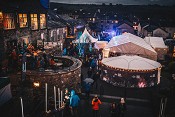
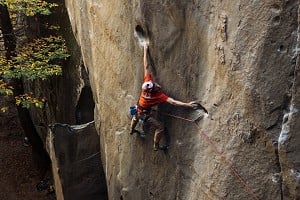
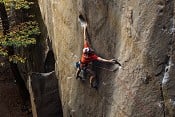
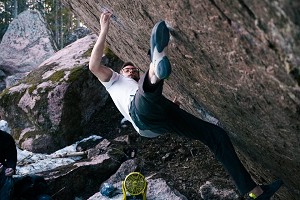
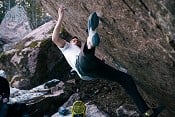








Comments